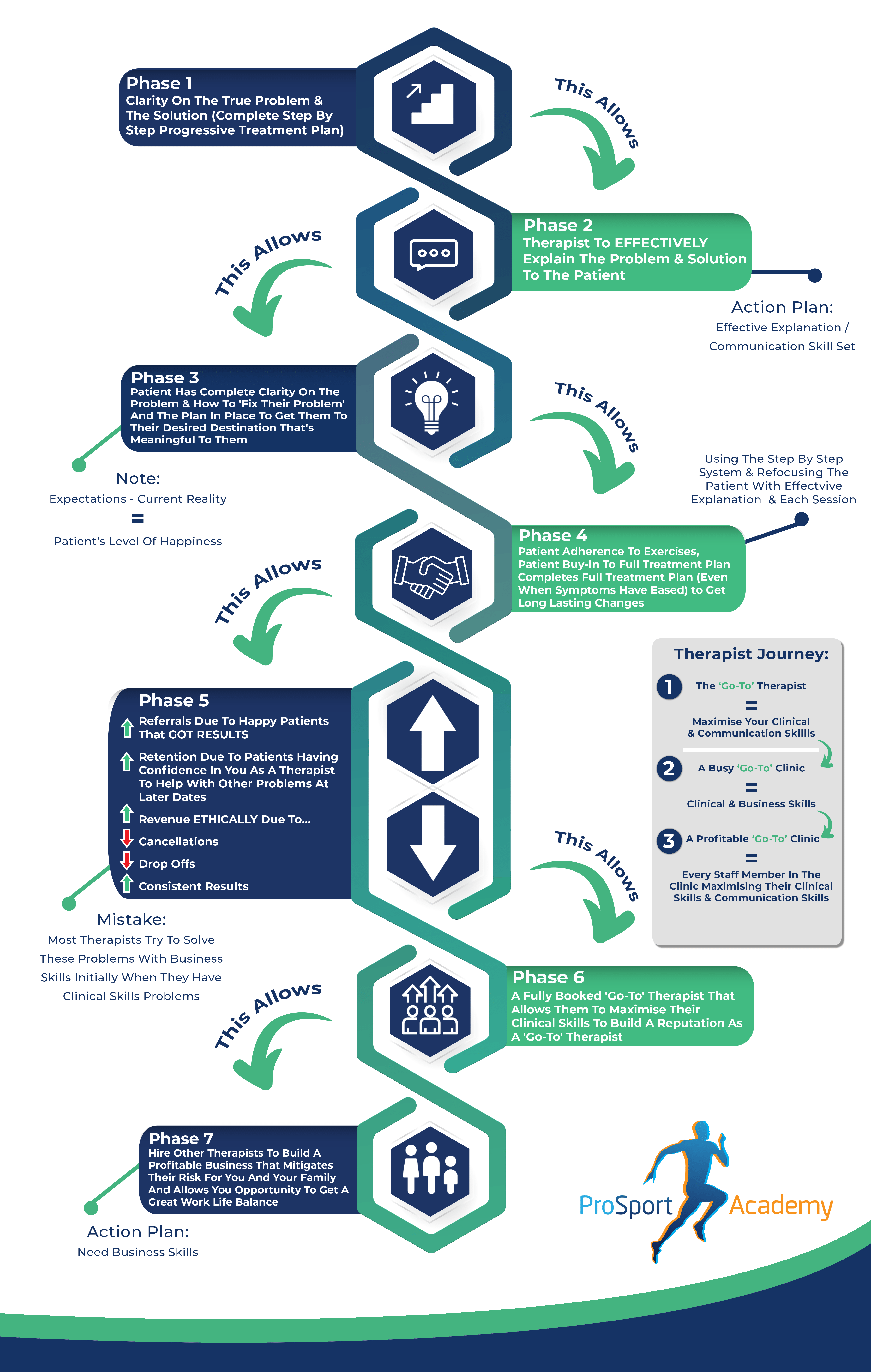A lot of therapists I speak to tell me they are frustrated by not being able to build their clinic’s faster by getting more new patients. Some even tell me they just can’t get past 10 patients, for example, a week, where some weeks been great and other weeks been quiet. The funny thing is, a lot of private practice physiotherapy or sports therapist owners say the same thing about their therapists and their biggest frustrations are that the therapists don’t get the patients back in enough and discharge too quickly.
This patient numbers rollercoaster obviously puts a lot of financial worries on the therapist, especially if they are self-employed or going out on their own. And so inevitably the therapist or business owner tries to go out and get more customers or pay a few hundred (or thousands of pounds/euros/dollars) on advertising, pay per click google ads or even Facebook ads). And sure that might increase the number of patients for a few weeks but then they notice the numbers dropping again…
That lack of consistent growth in patient numbers each week can be frustrating…
But here’s what I know to be true…
A patient comes into this therapists clinic for the first session which is straight forward. The patient is highly motivated at this point and the therapist can usually make some change in symptoms with a bit of hands-on treatment or tells the patient to do this exercise or that, exchanges money and off they go.
After a couple of sessions, the patient starts to feel a bit better or worse, doesn’t feel any change in symptoms. After 3 sessions or 4 usually, the ‘3-4 session patient progress slump’ kicks in, the progress slows down because the hands-on treatment isn’t as effective (or novel) as the first 1-2 sessions and the symptoms return again, minutes, hours or days later.
After session 3 to 4, the patient calls up and politely says one of three things;
- I’m feeling a bit better now, I’ll give you a shout if I need you again, thank you very much and is never seen or heard from again
- The patient makes a polite excuse about needing to cancel the appointment and will ring back again another time, next to be seen or heard from again despite you texting and calling them a couple of times
- The patient doesn’t turn up to their appointment and is never seen or heard from again
That’s if we are lucky and the patient is too polite to tell us some home truths that they are unhappy with the service we provided them in exchange for their hard earned cash…
Now obviously, there will be occasions where we will get some good results with patients too but for this blog post, I want to keep our attention on the ones who fall through the net…
So on average we might end up seeing a patient for 3-4 sessions in the clinic and the minute the pain is gone (if we’ve been good enough to ensure the pain experience is eliminated), they are off, never to be seen again.
The problem is we may have paid thousands of pounds on AdWords or Facebook or advertising and only been able to break even on that return if lucky from the 3-4 sessions.
And in reality for most people, if they go back into activities that are maybe too high level or not exposed to the proper stimulus prior to going back in again, from clinical experience, the pain experience may return again soon.
The reality is most people need that extra 1-2 session to build their confidence and resilience rather than just send them straight back into the real world. And for most therapists, from my experience of working with over 250 therapists around the world in my mentorship program, it is the ‘bridge’ between the first few sessions to getting patients back to the high-end activities that actually stop them from doing this.
This would be the equivalent of me getting a grade 2 hamstring tear patient pain-free on the bed after 3-4 sessions and then just putting them back into training and asking them to sprint flat out. The patient probably wouldn’t be too confident and I would only be guessing that they are able to tolerate the high loads placed upon their body. The systematic step by step graded exposure is CRITICAL for the patient to grow in confidence and build resilience and also CRITICAL for the therapist to know the patient is ready to go back to running or whatever it is they need to get back to, EVEN WHEN THE PAIN IS GONE!
So why is it so different in private practice? Because the patient is paying money? They can’t afford it? Yet they’ll spend X amount of money on X, Y or Z each weekend? This is a limited belief mindset from a lot of therapists and is really just a symptom.
The true cause if the patient can’t afford it? The patient just does not see the value.
This lack of clarity and uncertainty around where to go next (for both the therapist and patient), from my experience (because this was me too when I first started out in private practice) will result in the therapist saying things like:
“Try a run and see how you go”…
“Give it a few weeks and give me a ring if the pain doesn’t go”…
Other symptoms from a lack of clarity on a step by step plan, from my experience, include:
“Feeling Overwhelmed…”
“Feeling Rushed In Sessions…”
“Relying Too Much On Hands On Treatment…”
“Patients Too Passive On Bed & EXPECTING All Hands On Treatment…”
“Patients Not Buying Into The Treatment Plan…”
“Patients Not Even Having Clarity On What The Treatment Plan Is…”
“Therapist Not Even Having Clarity On What The Outline Of The Complete Treatment Plan Is…”
“The 3-4 Session Progress Slump…”
“Patients Not Showing Up To Appointments (Or Not Doing Their Exercises)…”
“Patients Cancelling…”
“A Lack Of Revenue, Retention & Referrals…”
So how do we solve these symptoms?
Below are my belief and thought processes on how to ethically grow a word of mouth predominantly private practice by ensuring that we get long-lasting results with every patient.
STEP 1: The therapist needs to have clarity on the patient’s true problem (not just the symptom) and the rough outline/solution (treatment plan) for the patient after the initial assessment. In order to get this, I use steps 1-4 of my 12 Step Successful Discharge Blueprint to truly understand the patient’s story and then use this to cross-reference it with the objective assessment so I can actually make sense of the objective assessment. You can learn more about my Successful discharge blueprint steps here or for a more in-depth view, grab a copy of my book The ‘Go-To’ Physio’ here.
It is ONLY WHEN the therapist has clarity on the problem and solution that Step. 2 happens.
STEP 2: This clarity allows the therapist to EFFECTIVELY EXPLAIN the problem and solution (treatment plan) to the patient in the first session. This then allows step 3 to happen.
STEP 3: The patient has clarity on the problem and the solution but most importantly what to do to get back to the things that are meaningful for their lives.
In this stage, the PATIENTS EXPECTATIONS are been set and any objections from the patient can be answered. From my experience, it is much better to set expectations in the first session rather than experience the ‘symptoms’ and stresses that most therapists go through in sessions 2,3 and 4 like a lack of adherence, buy-in, cancellations, frustrations from the patient about the lack of progress and so on.
A simple formula that I saw previously will help you understand why this is important:
EXPECTATIONS – CURRENT REALITY = LEVEL OF HAPPINESS.
If we can set expectations clearly in the first session then this will help minimise the mismatch between the therapists and patients expectations going forward and minimise the symptoms of a lack of clarity above. When this happens, step 4 can happen.
STEP 4: The patient’s motivation, adherence and buy-in to the exercises should all improve as they can see how this step by step progressive loading plan is meaningful to their situation and helping them get back to the things that are important to them. They clearly understand the value of each exercise, specific to them and the progress that has been made and more importantly, the progress that there is yet to come.
Most patients will cancel, drop off or become disinterested or frustrated when there is a perceived lack of progress. If we minimise these, then step 5 can take place.
STEP 5: The patient adheres and completes the step by step graded exposure program that helps them build confidence and resilience to meaningful things in their world. The result allows them to be able to confidently tell their friends and family about you and so referrals, retention of past patients and revenue all improve. This then allows step 6 to happen.
STEP 6: This step allows you to gain momentum by not only improving the number of times people come to see you ethically (and don’t drop off) so the previous average cash value of 4 sessions at £50 per session is £200 to now being an average of 6 sessions+ ethically which equals £300 per patient. If you have 10 new patients per month, getting their adherence, buy-in and commitment to complete the treatment plan is worth at least an additional £1,000 per month or £12,000 per year per 10 patients. If you see 20 new patients a month, that’s a potentially extra £24,000+ per year in revenue FROM EXISTING PATIENTS without even taking into consideration the new referrals from happy patients.
In my mind, it makes more sense to maximise my clinical and communication skills first and foremost so then when I add new business skills to grow my business I am maximising the return on every patient ethically rather than having a new patient drop off after 2-3 sessions. After step 6, then step 7 happens as demand increases.
STEP 7: This step is having a busy clinic and has other therapists come on board to help with the demand. At this point quality control is key and for a lot of private practice owners, the next problem for them then is their therapists discharging patients too quickly or their patients cancelling. Which again, from my experience, isn’t that the therapist is doing it deliberately, it’s just that they have a genuine lack of clarity on where to go next with the patient and so the symptoms of a lack of clarity tend to show their head again.
At this point, the clinical skills, communication skills and business skills are all critical for the private practice owner but more importantly, they must ensure that the therapists are maximising their clinical and communication skills.
So there you have how I use the exact same steps I use in pro sport in my own clinic. I first and foremost find the true cause of the injury. I then explain the plan to the player and coach along with a realistic prognosis of how long it is going to take to help with expectations from the player, coach and other board members of the club. We then get to work going through the various progressions, including when the pain has gone and ensured we have stressed the athlete enough and be completely confident they are ready to go back again without breaking down. This approach should look familiar to the one I’ve just described above.
People love having clarity and a plan in place to achieve an outcome. But before the patient can have the clarity, the therapist must first have the clarity and a step by step progressive systematic approach in place. Once they have this then the communication to the patient becomes a lot easier.
Mario is an osteopath in London who before working with us was seeing 10-15 patients per week. By gaining clarity in a step by step system, he was able to quickly increase his patients per week to 20-30 patients per week. Now Mario is continuing to refine this process further while starting to think about the possibilities of future growth as he plans to hire his first soft tissue therapist in the coming months as numbers continue to grow. The only thing Mario changed in this 90 day period was his clarity and ability to communicate effectively to his patients.
For me, it makes sense to truly maximise your staffs clinical and communication skills first and foremost so you can truly leverage the new business skills that you learn when you need to grow your business further. The problem is, a lot of therapists do not have a step by step system in place and are trying to bring business skills to a clinical and communication skill solution or their therapists do not have the step by step system in place and it results in a lot of business problems that actually can be resolved by maximising your clinical and communication skills.
Thanks for reading.
Dave

Key Takeaways
Confidence & Clarity ALLOWS You…
- To Find The True Cause Of The Problem While Working Smarter NOT Harder
- To Design An Outline Of A Complete Treatment Plan After The Initial Assessment
- To EXPLAIN EFFECTIVELY To Your Patient The Problem & Solution (Treatment Plan)
- To Set Your Patients Expectations Accordingly After The First Session So There Are Not Problems In Later Sessions, Cancellations Or Drop-Offs
- To Offer A Genuine Prognosis Based On Logical Step By Step Progressions That Is Meaningful To The Patient
- To Improve Adherence & Total Patient Buy-In From The Patient As They Now See The Value Of The Exercises In Helping Them Get That Meaningful Bespoke Outcome.
- To Minimise Drop Offs, Cancellations, No-Shows Or Unhappy Patients
- To Increase Your Revenue Per Patient Because Your Patients Are WOW’d And Actually Got The Results They Expected In The First Place & Then More
- To Increase Retention Of Those Patients In The Future As They Now Have Confidence In You To Get Results And Won’t Hesitate To Come Back
- To Increase Referrals From Those Patients Because They Want Family & Friends To Experience The Transformation And Are Confident That It Is Safe For Them To Tell Their Friends And Family About You
- To Have Financial Freedom For Yourself/Your Family By Having A Predictable & Consistent Diary For You And Your Therapists Every Single Week.
For more information on my own step by step progressive graded exposure progressions click here to pick up a copy of my ‘Go To’ Physio book.




